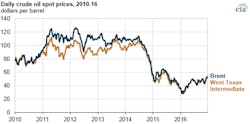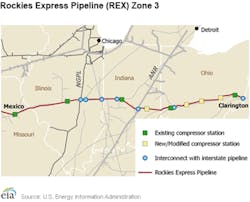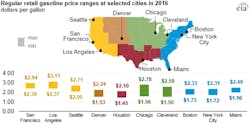Crude oil prices increased in 2016, still below 2015 averages
Graphic courtesy of the EIA
At the end of 2016, crude oil prices were above above $50 per barrel (b). The annual average West Texas Intermediate (WTI) crude oil price in 2016 was $43/b — down $5/b from 2015 — and the WTI price ended 2016 at $53/b, $16/b higher than at the end of 2015. Brent prices ended 2016 up $17 from the end of 2015 at $54/b, while the 2016 annual average of $44/b was $8 below the 2015 average, according to the U.S. Energy Information Administration.
High production and inventory levels negatively affected crude oil prices throughout most of 2016 even with high demand for petroleum products. Now, however, markets appear to be anticipating tighter balances than previously forecast, possibly caused by recent Organization of the Petroleum Exporting Countries (OPEC) agreements and additional pledges by key non-OPEC producers.
Average crude oil prices forecast to rise as markets move toward balance
Benchmark North Sea Brent and West Texas Intermediate (WTI) prices are expected to average $53 per barrel (b) and $52/b, respectively, in 2017, close to their levels during the last three weeks of 2016, noted the EIA. Average forecast prices will rise to $56/b and $55/b, respectively, in 2018.
The EIA’s price forecasts have wide uncertainty bands, consistent with contract values for future delivery. Strong demand and the recent agreement to reduce production among OPEC members and key non-OPEC oil producers, are putting upward pressure on crude oil prices. However, the industry should not see significant crude oil prices in 2018 because forecast increases in global production should provide downward pressure on prices. Despite the recent OPEC agreement, the EIA expects global petroleum and other liquid inventory builds to continue at a slowing rate in 2017 and 2018.
Graphic courtesy of the EIA
REX Zone 3 capacity expansion enters full service
Tallgrass Energy and Rockies Express Pipeline LLC’s (REX) Zone Three Capacity Enhancement Project was completed recently. The project will provide an additional 800 million cubic feet per day (MMcf/d) of east-to-west capacity out of Ohio and into Midwestern markets, according to the EIA.
The expansion project increases REX’s Zone 3 east-to-west capacity to 2.6 billion cubic feet per day (Bcf/d) by adding three additional compressor stations and upgrading two others. The project received approval from the Federal Energy Regulatory Commission approved the project in March of 2015 and it is estimated to have cost $532 million.
S&P Global Platts offers oil and gas outlook for 2017
The year 2017 is expected to produce a more balanced supply and demand environment as a huge stock overhang disappears by the third quarter, according to Platts Analytics. Along with the first OPEC-led global production cut in 15 years, this points to a slow oil and gas industry recovery.
While 2016 saw a large degree of price convergence between regional markets in 2016, time will tell if a strong global gas market will emerge further in 2017. Oil indexation has been the basis for traditional pricing in international gas trade, but the oil price volatility of the last few years, which increased liquefied natural gas (LNG) production and growing competition between LNG and pipeline gas, have led to a rethink. The trend for de-indexation to oil is likely to continue in 2017, according to Platts.
Graphic courtesy of the EIA
US gasoline prices in 2016 were lowest since 2004
U.S. 2016 regular retail gasoline prices averaged $2.14 per gallon (gal), 29 cents/gal (12 percent) less than in 2015 and the lowest annual average price since 2004. The main cause of lower gasoline prices were lower crude oil prices in 2015. Gasoline prices did not exceed $3.00/gal in nine of the 10 cities for which the EIA collected weekly data.





